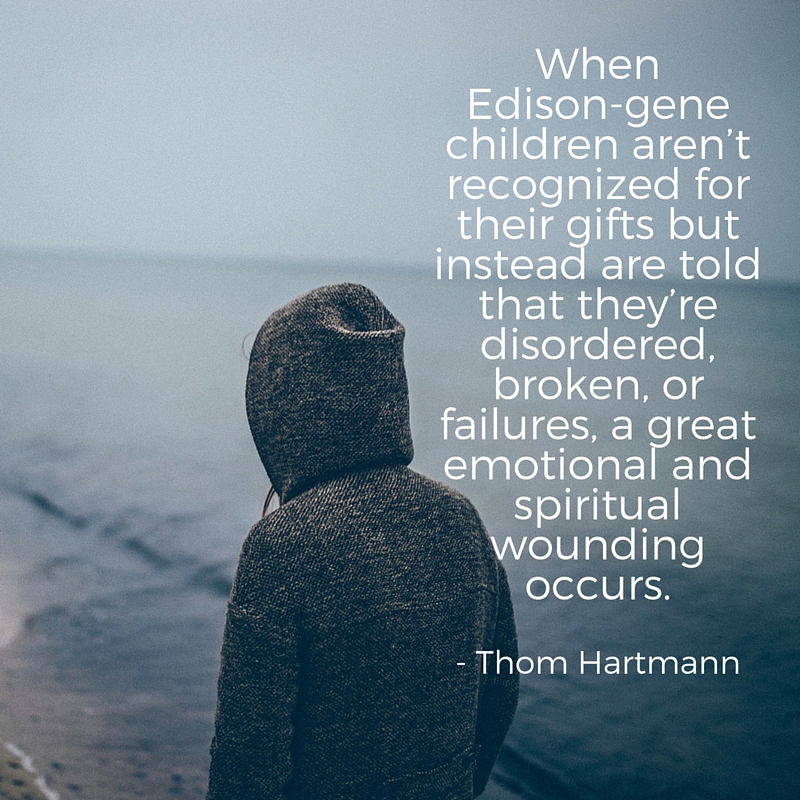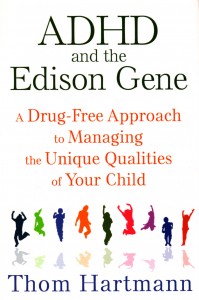Book Insight: ADHD and the Edison Gene
I first read Thom Hartmann in my mid-20s when I was informally diagnosed with ADD. I was highly anti-meds at the time so there didn’t seem any point in getting officially diagnosed. Plus I wasn’t convinced that it was a disorder. (I’m still not.)
Hartmann’s books helped me understand how to choose environments that suited me and helped me be kind to myself when I didn’t fit with cultural expectations about work.
This latest, “ADHD and the Edison Gene,” takes his initial ideas and updates them with more current science. Instead of describing ADD brains as hunters (in a hunter/gatherer vs. farmer paradigm), he’s using the “Edison gene” and inventors. I’m a fan of all of it. I don’t care if you think of me as an inventor, a hunter or a superhero as long as it’s positive and creates an environment where we can do our best work together.
In very brief summary, this book posits that what our culture labels ADD/ADHD arises from a combination of factors that includes a genetic trait for novelty-seeking, a mismatch between innovative brains and our assembly-line culture, and possible environmental factors, like diet. Many of the traits of ADD are positive and adaptive in the right contexts and we should be very cautious of over-medicalizing creativity and innovation.
For a somewhat deeper dive, below are many of my favorite parts of the book. To start off, here’s how Hartmann describes people with the Edison gene.
“Edisongene children and adults are by nature:
- Enthusiastic
- Creative
- Disorganized
- Non-linear in their thinking (they leap to new conclusions or observations)
- Innovative
- Easily distracted (or, to put it differently, easily attracted to new stimuli)
- Capable of extraordinary hyperfocus
- Understanding of what it means to be an “outsider”
- Determined
- Eccentric
- Easily bored
- Impulsive
- Entrepreneurial
- Energetic
All of these qualities lead them to be natural:
- Explorers
- Inventors
- Discoverers
- Leaders
ADHD behaviors in context
Hartmann provides a solid case that ADHD behaviors are beneficial in hunter/gatherer cultures and beyond. (Later in this blog post, we’ll see a great study about how ADHD brains are great at taking in their environment and how they tend to be more creative than average.)
ADHD experts often noted that it’s not that those with ADHD can’t pay attention to anything; it’s that they pay attention to everything. A better way to characterize the distractibility of ADHD is to describe it as scanning. … Thomas Edison eloquently described how his combined distractibility and impulsiveness helped him in his “hunt” for world transforming inventions. He said, “Look, I start here with the intention of going there (drawing an imaginary line) in an experiment, say, to increase the speed of the Atlantic cable; but when I have arrived part way in my straight line, I meet with a phenomenon and it leads me off in another direction, to something totally unexpected.”
Hartmann also gives us a quote from a modern “hunter” who came across his hypothesis and told him:
There’s still a lot of hunter left in our genes and in our hearts. In a world dominated by farmers and corporate types, there are plenty of full-blooded hunters trying to hunt for a living. Those, my friend, are entrepreneurs. . . . Hunters and those with ADD are astoundingly similar. I suspect most entrepreneurs, if they sat still long enough, could be diagnosed as having ADD. . . . And I’ve passed my ADD (or hunter) genes to my children.
And he gives us this from a paper titled “Revolution in Evolution: ADHD as a Disorder of Adaptation:”
… he and his coauthors strongly argued that ADHD children shouldn’t be told they have an illness, but that instead parents and teachers should emphasize their positive characteristics. “In reframing the child who has ADHD as ‘response ready,’ experience-seeking, or alert,” they wrote, “the clinician can counsel the child and family to recognize situations in modern society that might favor such an individual, both in terms of school environments, as well as future career opportunities, e.g., athlete, air-traffic-controller, salesperson, soldier, or entrepreneur.”
Is there really a gene?
Well, there are numerous genes associated with ADHD, but there is a specific novelty-seeking gene that’s received a lot of press in recent years. Here’s a quote from Dr. Robert Moyzis who did a NIMH-funded study of the novelty-seeking gene:
“We found a significant positive selection for the genetic variation associated with ADHD and novelty-seeking behavior in the human genome. This study strengthens significantly the connection between genetic variations and ADHD. It also provides a clue as to why ADHD is so pervasive.”
Hartmann calls this the “crisis-survival gene” and posits that it helped humans survive dramatic shifts in climates over the past 150,000 years. In this book, he gives us a sweeping epic of human evolution and planetary crisis bottlenecks. Bear with me during this long quote and you’ll get a sense for the epicness of it all:
“Hunters rarely suffer from the affliction of farmers—famine—because when a hunting area is hit by drought or flood, heat or cold, such people simply move to another place. When one primary food plant or animal dies off, they switch to others. When the pickings get slim, hunters expand their range.
The diet of hunters is incredibly diverse because of their ranging and nomadic existence. This is why, until the development of antibiotics around the time of World War II, no agricultural peoples in the eight thousand–year history of agriculture had achieved the health of hunters. Both modern and ancient hunters consistently have had stronger bones and taller bodies, have lost fewer teeth, and have lived longer than typical Europeans from the earliest cities as recently as fifty years ago.
While popular culture portrays the lives of hunter people as harsh and miserable, the ones I’ve met and known on four continents enjoy high-quality lives. Indeed, according to anthropologists, hunters represent the original leisure society, typically working only two to four hours a day to secure all their food and shelter needs, and spending the rest of the time playing with their families, talking, singing, and building community.”
My brain is on board for working fewer than four hours a day and spending the rest of the time playing and building community!
Yes, but show us the science!
This book cites some of my favorite studies — let’s look at ’em:
ADHD is associated with higher levels of creativity, according to a study published in 1991 by researchers Geraldine Shaw of Georgetown College and Geoffrey Brown of the University of East Anglia in England. They found “a stable pattern of characteristics associated with ADHD and high intelligence.” Because of their “distractibility,” these children often keenly notice things in their environment and think divergently.
Shaw and Brown bluntly stated that “those with attention problems . . . showed higher figural creativity.” The reason, they concluded, was that “despite (or perhaps because of ) their inability to focus attention normally, they are able to process and use large amounts of relatively scattered bits of information which appear to overwhelm, or to be ignored, by more verbally oriented [normal] children.”
In another study published by the Journal of Creative Behavior, researcher Bonnie Cramond found that a “higher creativity score, sensation seeking, and use of imagery are common descriptors of creative individuals.” She noted that ADHD children “have more internal distractions from fleeting sensory input” and quoted a 1992 study that “speculates that such spontaneous and diverse ideation may be part of the process that fosters more creative responses on a test of divergent thinking.”
“In summary,” Caramond wrote, “there is evidence to support the hypothesis that both creatives and those classified as ADHD show greater indications of mixed laterality and anomalies in cerebral dominance, more spontaneous ideation, higher levels of sensation seeking behavior, and higher energy and activity than do normal populations.”
This book cites one of the best studies of kids with ADHD and nonhyperactive kids. In brief, all the kids were given 120 cards to memorize in a room with six posters unrelated to the information on the cards. Unsurprisingly, the nonhyperactive kids did better at memorizing the cards. (If you want the numbers it’s M=6.32, SD=1.57 for nonhyperactive kids compard to M=4.7, SD=1.65 for the hyperactive kids.)
BUT the hyperactive kids had much better recall of the posters on the walls. Check it out:
“In contrast to their inferior recall of the targets,” the researchers discovered, “hyperactive children recalled significantly more of the most extrinsic stimuli, that is, the six posters that were affixed to the walls of the testing room, recalling, on average, 2.79 extrinsic pictures, whereas their nonhyperactive peers recalled only .58 pictures.” Further, the ADHD children were more competent at knowing whether their memory of detail was from the 120 target cards or from the “irrelevant” six posters in the room. “Overall,” the researchers wrote, “hyperactive children were significantly better than their nonhyperactive peers at discriminating the original stimuli, after controlling for response bias.”
Also the ADHD kids were better at knowing what was and wasn’t on the cards: “hyperactive children had approximately 50 percent fewer false alarms (i.e., affirming cards that were not originally shown) than nonhyperactive children. … they committed fewer false recognitions at each level of missing information than their nonhyperactive peers.”
So basically we’re badass hunters who can constantly scan our environments in ways that produce creativity and
Okay but seriously, what about this gene?
Important note: it’s not that there’s one gene that’s definitively linked to all ADHD:
[ADHD] isn’t even a single condition—most scientists in the field are coming to the conclusion that the label is a “wastebasket diagnosis,” that is, a giant category that encompasses many different conditions, with many—perhaps most—of them not being pathologies or illnesses at all, but just variations on the human condition. … As of this writing, there are forty-nine different genes and/or gene variations that have been implicated in ADHD. While the DRD4 gene is still considered the major one, others color or shade the type of ADHD a person has, pushing them more towards hyperactivity or impulsivity or scanning behaviors.
That said, there seems to be a link both with low levels of dopamine and ADD/ADHD behavior: “People whose dopamine levels are genetically low seek out stimulation in the world. People with genetically high levels of dopamine tend to be more passive and less sensation- or novelty-seeking in their behaviors.” And there’s a link with the 7R variation of the DRD4 dopamine gene and novelty-seeking.
Is ADHD a genetic disorder then? Probably not because the 7R variation is quite common. Genetic disorders tend to be rare and only show up in specific populations, not like the worldwide spread of the 7R variation.
Moyzis, who worked extensively on the gene said:
Our major finding, to our amazement, [was that] unlike many disease genes that have been previously identified, where it was quite clear that the variant wasn’t doing any good for the individual who contained it, [in this case] we have strong evidence for positive selection working on this variant.”
He went on to say:
It almost seems that everything we do to look at differences among either kids or college students, including reaction time studies, you keep on coming up with really positive things, no matter what we look at. One of the last ones we did had to do with some of the tests the kids have been given. When I look at kids who have the normal variation they are almost boringly uniform. They’re always right at the middle of these distributions. And it’s always the 7R-allele kids who are out at the extremes. And that can be extremely good. Some of the brightest kids, especially on the spatial tasks, always end up being the 7R-allele kids; we never find the other kids out at that extreme.
This leads Hartmann to conclude that the genetic variant isn’t a disorder at all: “The gene most closely associated with ADHD is also associated with what scientists call novelty seeking and many lay people would call a dimension of ‘insatiable curiosity.'”
Back to Moyzis:
Our data show that the creation of the 7R allele was an unusual, spontaneous mutation, which became an advantage for humans. Because it was an advantage, the gene became increasingly prevalent. This is very different from other genes that predispose to genetic disorders, where the mutations are detrimental. We believe this helps explain why a disorder with such a strong genetic association is so common today. … The fact that it arose right around the time that we like to think that modern civilization arose seems to be more than just coincidence. It’s an interesting speculation.
Essentially “How the ADHD Kids Saved Civilization.” Or as Moyzis wrote in the Proceedings of the National Academy of Sciences:
If the DRD4 7R allele originated 40,000 years ago, one might ask what was occurring at that time in human history? It is tempting to speculate that the major expansion of humans that occurred at that time, the appearance of radical new technology (the upper Paleolithic) and/or the development of agriculture, could be related to the increase in DRD4 7R allele frequency. Perhaps individuals with personality traits such as novelty seeking, perseverance, etc. drove the expansion (and partial replacement).
Hartmann concludes:
In today’s world, a child failing school at the age of ten would be diagnosed, medicated, forced into a behavior modification program to “take charge” of his different learning style. Then, his spirit broken, he would either learn to conform and fit in or be shunted into special education. … Had Franklin simply “fit in,” King George III would have been very pleased—it’s possible the American Revolution would never have happened. And the world might not have electricity or bifocal glasses or Franklin stoves, or even a public library or postal system.
The rest of the book
That was less than half of the book and Hartmann goes on to talk about:
- Brain development
- Drugs
- Exercise
- Nutrition
- Structure
- Positive child-rearing
- Education
- Girls and women with ADHD
- Spirituality
- “How Edison-Gene Children May Change the World”
Those chapters can be somewhat rambling and if you’ve read other ADD/ADHD books you’ll see information that you’re familiar with mixed in with new ideas. Much of this isn’t as hands-on and immediately actionable as the information in FAST MINDS, but it’s empowering and enjoyable to read.
Get this book if you want to feel great about your brain or if you need a powerful context for someone you love who’s been diagnosed with ADD/ADHD. If you’re feeling impatient and don’t want 150,000 years of world history and a treatise on how we need to change our educational system, this is not the book for you right now.
And lastly because the subtitle says “a drug-free approach,” I want to add that while exercise, nutrition, structure and training can all help, it is also more than okay to use medication to help an overwhelmed ADD brain take full advantage of those other healing modalities. If you, your child or someone you love has been living with an ADD brain in a hostile culture/environment, you may want to combine many different approaches to create balance and freedom. Hartmann’s book creates a wonderful context for understanding that our brains are powerful and amazing. I hope inside that context people will try a lot of different ways to optimize their brains and then keep doing what works.



